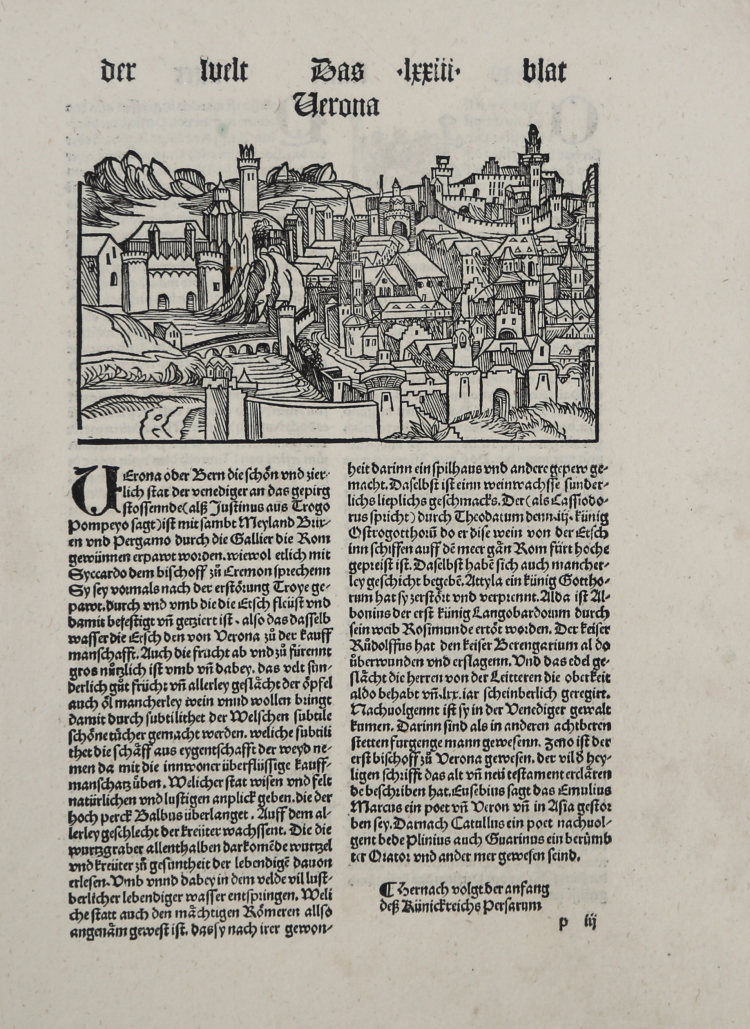



| Reference: | S39479 |
| Author | Johann Schönsperger |
| Year: | 1496 |
| Zone: | Verona |
| Printed: | Augsburg |
| Measures: | 215 x 307 mm |


| Reference: | S39479 |
| Author | Johann Schönsperger |
| Year: | 1496 |
| Zone: | Verona |
| Printed: | Augsburg |
| Measures: | 215 x 307 mm |
Imaginary view of the city taken from the Liber chronicarum translated by Georg Alt: Das Buch der Croniken unnd Geschichten. Augsburg: Johann Schönsperger, 1496.
The Liber Chronicarum by Hartman Schedel, was first published in Latin on 12 July 1493 in the city of Nuremberg, printed by Anton Koberger, the most successful publisher in Germany. A German translation followed on 23 December 1493. Due to the great success and prestige of the Chronicle, pirate editions soon appeared on the market. Johann Schönsperger (c. 1455-1521), a printer working out of Augsburg, published smaller editions of the Chronicle in 1496, 1497, and 1500 in German and Latin.
The Schönsperger's pirated German editions of the Nuremberg Chronicle published in Augsburg, containing more illustrations than those in the original Nuremberg editions. Being a piracy, and without access to the original blocks, Schönsperger employed artists to make new woodcuts. This allowed Schönsperger to use a smaller format than that of the Nuremberg editions. Numerous woodcuts are repeated in this edition of the Chronicle: one showing a walled city appears five times, representing England, Poland, Geneva, Milan, and Tiberias, while another woodcut was used for Mainz, Naples, Lyons, Bologna, and Aquileia; another of a portrait of a scholar holding a book in his lap and a pair of spectacles in his hand is used for nine different persons, including Paris, Virgil, Sextus Julius Africanus, and Rhazes, all of whom belong to the period before the invention of spectacles. Because it was published in German, considerable emphasis was put on the German-speaking regions to increase its popularity and readership.
The Liber Chronicarum was a milestone in the history of the town views; in that, for the first time the representations of cities, although still often tied to supposition if not fantasy, assume a prominent role and no longer solely one of embellishment, demonstrated by the growth in size, coming to occupy up to half a page, and the care taken in the engraving. The purpose of the Liber Chronicarum's woodcuts is to provide the reader with an idea of the forma urbis, so it is often futile - with a few exceptions - to seek elements of adherence to reality.
Woodcute, very good condtion. Rare.
Johann Schönsperger (1455-1521 circa)
|
Schönsperger set up a print shop in 1481 together with the goldsmith Thomas Rüger († 1483) and worked closely with his stepfather Johann Bämler († 1503)[1]. Together with other Augsburg printers, the company was able to dominate the book market for German literature in Augsburg between 1480 and 1500. Schönsperger went partially bankrupt in 1507 and never recovered financially. In 1508, probably through the mediation of Konrad Peutinger, he became the secret printer to Emperor Maximilian I. He printed the “Theuerdank” and the prayer book for the Order of St. George for the emperor. The types designed for these two projects are milestones in the development of Fraktur. His Bibles (Schönsperger Bibles) of 1487 and 1490 also became famous (see the article Pre-Lutheran German Bibles). In 1497, Schönsperger's print shop in Augsburg published the so-called “Kleine Schedel”, an abridged edition of Schedel's World Chronicle. As this pirated edition was printed on poorer quality paper, the Augsburg edition is even rarer today than the Nuremberg original.
|
Johann Schönsperger (1455-1521 circa)
|
Schönsperger set up a print shop in 1481 together with the goldsmith Thomas Rüger († 1483) and worked closely with his stepfather Johann Bämler († 1503)[1]. Together with other Augsburg printers, the company was able to dominate the book market for German literature in Augsburg between 1480 and 1500. Schönsperger went partially bankrupt in 1507 and never recovered financially. In 1508, probably through the mediation of Konrad Peutinger, he became the secret printer to Emperor Maximilian I. He printed the “Theuerdank” and the prayer book for the Order of St. George for the emperor. The types designed for these two projects are milestones in the development of Fraktur. His Bibles (Schönsperger Bibles) of 1487 and 1490 also became famous (see the article Pre-Lutheran German Bibles). In 1497, Schönsperger's print shop in Augsburg published the so-called “Kleine Schedel”, an abridged edition of Schedel's World Chronicle. As this pirated edition was printed on poorer quality paper, the Augsburg edition is even rarer today than the Nuremberg original.
|